Metro Manila Subway: When Right of Way Gets in the Way
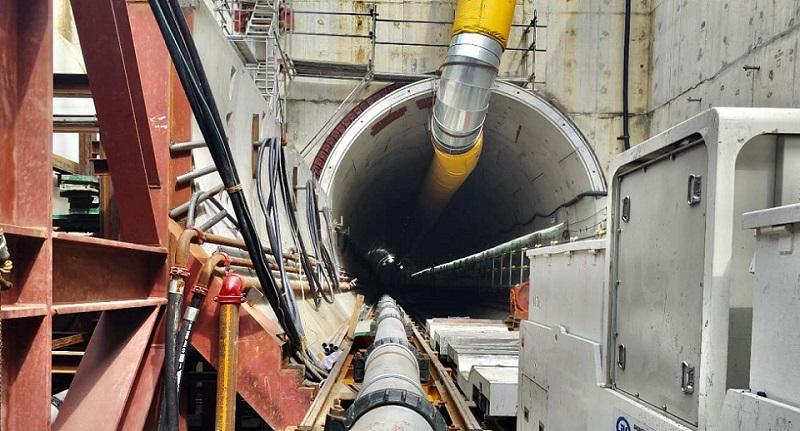
E
merrie Joy Fegarido, a guest experience representative for an international hostel chain, commutes from Novaliches to Makati daily, spending at least four hours a day going to and from work six days a week.
Emerrie, 29, has been a commuter in Metro Manila for nearly a decade, with her travel routine a daily struggle of long wait times, traffic snarls, different modes of transport, frequent transfers, and hurried walks.
“My usual route is I walk going towards the UV Express terminal and then go to MRT North Avenue and then from there, either mag-e-EDSA (take the EDSA) Carousel bus or MRT going to either Guadalupe Station or Buendia Station,” Emerrie said.
“From there, I’ll take a jeep from the MRT station going to JP Rizal, or kung (if) Buendia naman, going to Petron Makati Avenue or Buendia Avenue tapos (and) both routes, jeepney routes, I have to walk pa ulit pagbaba tapos ganon po ulit ‘pagka ‘pag pauwi,” she added matter-of-factly.
(From there, I'll take a jeep from the MRT station going to JP Rizal. If via Buendia, it will be going to the Petron station on Makati Avenue or Buendia Avenue. Both are jeepney routes and I have to again walk when I alight. It will be the same route going home.)
With less than seven hours of sleep daily on average, Emerrie wakes up one-and-a-half hours before she leaves her house in Novaliches around 7 a.m. Her commute to the office takes two to two and a half hours. Her travel back home takes longer.
“”Pag naabutan ka sa carousel ng Buendia or Guadalupe, ‘yung long lines or kasi walang… hindi mabilis ‘yung dating ng susunod na bus. Ang mas matagal pa pala is ‘yung UV Express sa TriNoMa going to Novaliches,” she says.
(If you get caught in the carousel of Buendia or Guadalupe, there are long queues because... there is no fast turnover of buses. The UV Express from TriNoMa to Novaliches takes even longer.)
The commute takes a toll not only on her energy but also on her pocket. Emerrie's daily fare costs P200 back and forth, but she said this could go as high as P270 for a one-way motorcycle taxi ride. Opting for ride-hailing services, Emerrie would have to pay up to P600 or more.
She is one of the nearly 520,000 daily commuters who could already be using the Metro Manila Subway Project (MMSP) had it not been delayed. It was targeted to start operations in 2021.
Three years later, the project is still at 16% physical progress—pertaining to the civil engineering works—as of August 2024, according to its implementor, the Department of Transportation.
Touted as the “Project of the Century,” the P488.48-billion project is a 33-kilometer underground railway system through eight cities in Metro Manila..
The MMSP will have 17 stations – Valenzuela where the depot will be located, Quirino Highway, Tandang Sora, North Avenue, Quezon Avenue, East Avenue, Anonas, Katipunan (Camp Aguinaldo), Ortigas Avenue, Shaw Boulevard, Kalayaan Avenue, Bonifacio Global City, Lawton East, Senate-DepEd, NAIA Terminal 3, FTI, and Bicutan.
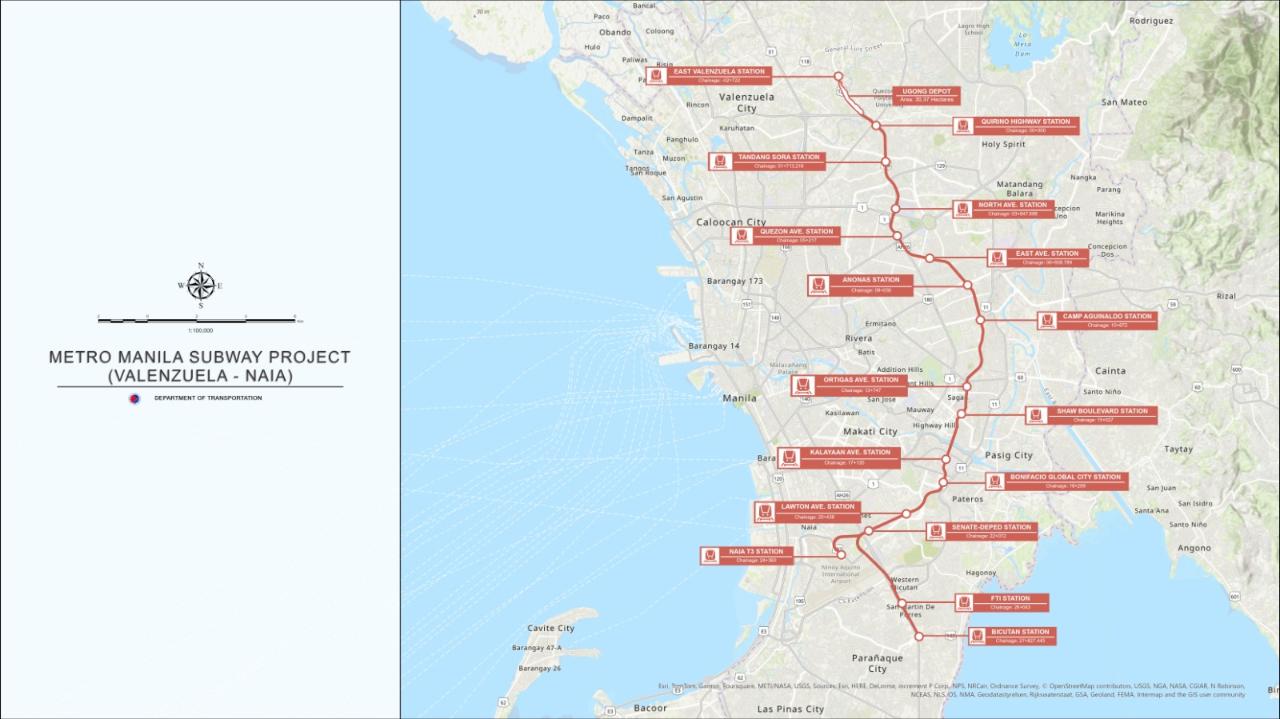
The subway is targeted to cut the travel time between Quezon City and Ninoy Aquino International Airport (NAIA) in Pasay City, the country’s main gateway, to just 35 minutes from the present 70 minutes.
The development was fantastic news for the Emerries of Metro Manila.
“(This would make a significant difference) lalo kung matatanggal na ‘yung palipat lipat ng transpo, isang mas mahabang route na isa na lang ‘yung sasakyan mo (especially if you don’t have to move from one mode to another, with a longer route with just one vehicle),” Emmerrie said.
(It would make a significant difference if we can do away with having to transfer between vehicles instead of just one long route.)
Once operational, Emerrie could cut her commute by taking the Tandang Sora station and alighting at the Kalayaan Avenue station. She has to wait four more years, however, because the subway is expected to be operational by 2028.
Called the Mass Transit System Loop or Light Rail Transit Line 5 under the administration of the late former President Benigno “Noynoy” Aquino III, the project was removed from the pipeline due to scheduling constraints, as officials said the alignment was taking up too much time.
It was then adopted as one of the key projects under the “Build, Build, Build,” Program of former President Rodrigo Duterte, and called the “Mega Manila Subway” as approved by the National Economic and Development Authority (NEDA) in 2017.
“In fairness to the previous presidents, to our previous administrations, the reason why the subway was never pursued was because of the prohibitive costs,” DOTr Undersecretary for Rails Jeremy Regino told GMA News Online.
“Mas mura ‘yung elevated noon kasi wala pa tayong masyadong maraming tall buildings, tall structures, so hindi katulad ngayon, we already have so many tall buildings and structures, so right of way is very costly. That’s the difference,” he added.
(It was cheaper then to have elevated [rails] because there were not much tall buildings, tall structures, unlike now, we have so many tall buildings and structures, so right of way is very costly. That’s the difference)
The project has since been carried over to the administration of President Ferdinand “Bongbong” Marcos Jr., as part of its P9-trillion Infrastructure Flagship Projects (IFP) pipeline.
“We are in the midst as well of a ‘railway renaissance.’ The Metro Manila Subway Project has logged significant accomplishments in its tunneling works. Sa puntong ito, katumbas na ng tatlo hanggang anim na palapag ang lalim ng nahukay, at tuloy-tuloy na umuusad sa susunod na istasyon,” President Ferdinand “Bongbong” Marcos Jr. said in his State of the Nation Address (SONA) in July.
(At this point, the tunneling works are equivalent to three to six stories underground, and these continue to the next stations.)
The MMSP is envisioned to be interconnected with other rail systems — the Light Rail Transit Line 1 (LRT1), the Metro Rail Transit Line 3 (MRT3), and the Metro Rail Transit Line 7 (MRT7) through the Common Station; the Light Rail Transit Line 2 (LRT2) at the Anonas Station; and a physical run through into the North-South Commuter Railway Extension (NSCR-Ex) at the FTI and Bicutan Stations.
“All megacities now — all major cities, the highly populated urban centers in the world right now — megacities, they now have subways, because that’s the only way to mitigate the transportation problem or traffic in a metropolis,” Undersecretary Regino said.
“Megacities have high populations and if you have high populations, you have to have a mass transport system so if you compare the jeepney, the bus, or private vehicles with the capacity of the train system, there is no basis of comparison. Talagang malayo (It is really far). In one train, how many buses is it equivalent to? How many jeepneys is it equivalent to?” he added.

Construction was set to take place in two phases: partial operations covering the first three stations — Quirino Highway, Tandang Sora, and North Avenue; and the second phase covering the rest of the stations.
Based on the MMSP’s final Environmental Performance Report and Management Plan dated September 27, 2019, construction for the partial operability section should have started in 2019, and operated in 2022.
Partial operations were targeted to start by 2021, having eight-car train sets that can carry up to 2,200 passengers per train, running up to 80 kilometers per hour, and trains arriving at stations every five minutes.
Construction of the remaining sections should have started in 2022 and were then targeted to begin operating in 2025.
“Those were plans, pero (but) eventually, we’ll have to grapple with realities na (that) right of way’s not that easy,” Regino said.
In July 2023, DOTr Assistant Secretary for Rails Jorjette Aquino was quoted as saying that the government was no longer looking into partial operability targeted in 2027 but instead planned to roll out full operations in 2029.
However, during the interview with Regino in August 2024, he said partial operation — from Valenzuela to the Ortigas or Shaw stations — is expected to be available in 2028. Full operation will be by 2030 or 2031.
The first tunnel boring machine (TBM) — the mechanism used to excavate tunnels — was lowered in Barangay Ugong, Valenzuela City on June 12, 2022. The DOTr targeted to have six TBMs in 2024, and at least 19 working simultaneously in the next few years.
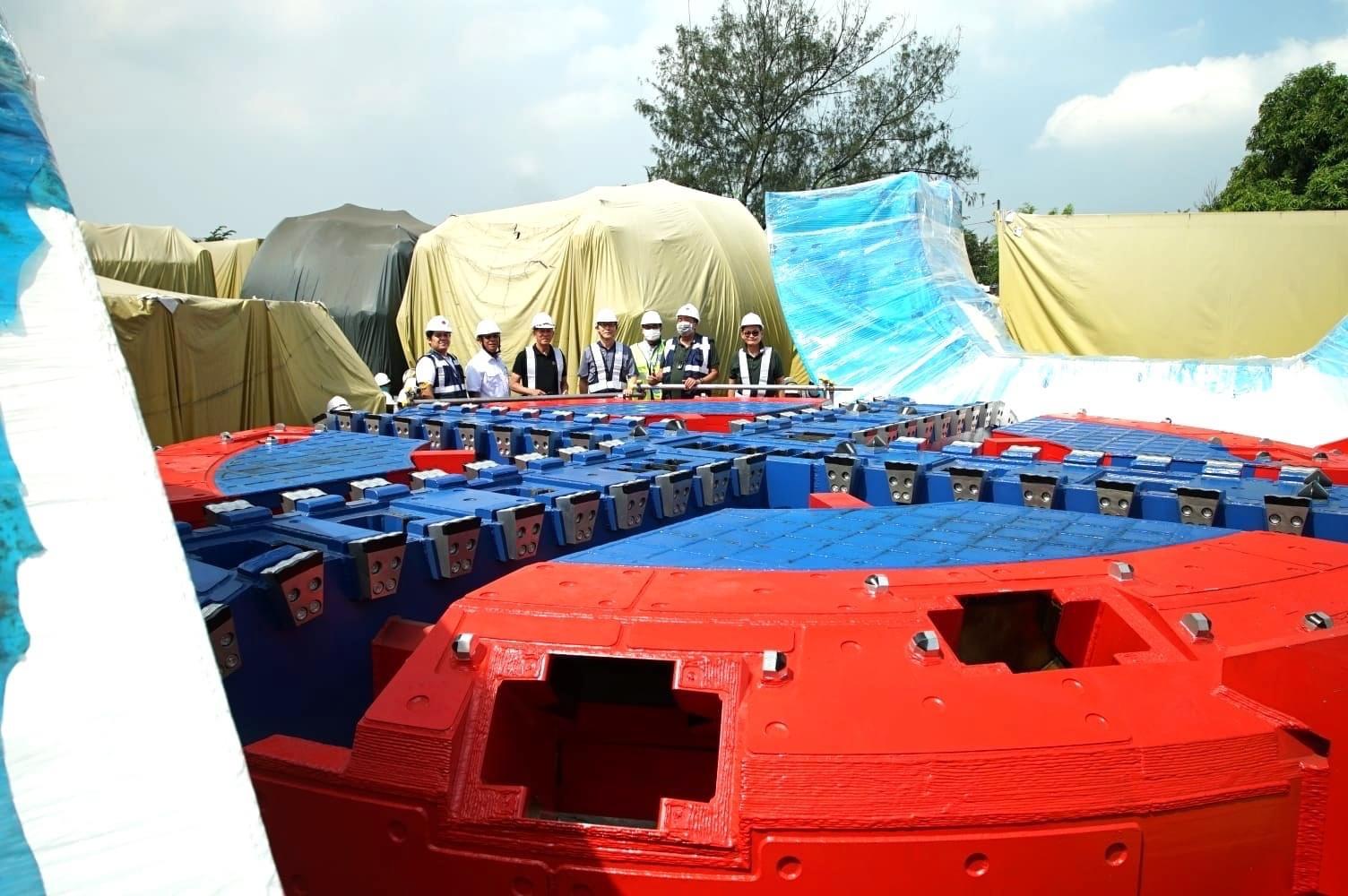
T
he main cause of delay, according to the DOTr, is securing pieces of property on the right of way which remained a key obstacle to the substantial progress. Regino said acquisitions were still at 50%, making them the main cause of delay.
“It’s a major cause, if not the main cause of delay —the right of way,” Regino said in an interview at his office. “For the tunnel boring machines that have been operating, continuous ang operation nila, so okay tayo.”
Regino explained that under the current Right of Way Law, property owners have rights up to 50 meters below from the ground level. Anything lower is already public domain.
On average, the MMSP is 15 to 20 meters below ground level, equivalent to four-storey buildings.
“Basically ang right of way natin ngayon (right now) is we still have to pay private owners, even though we are already underground. The difference is, wala tayong gigibain kasi nasa ilalim (we will not demolish because it is underground). So in a sense, mas madali kasi ‘yung elevated may gigibain ka pa eh. Eh sa ilalim wala ka nang gigibain (it is easier because for elevated, there are demolishments while underground, there are none),” he said.
President Marcos in April signed Administrative Order 19, creating an Inter-Agency Committee for Right-of-Way Activities for National Railway Projects to streamline the process of land acquisition for projects across the country.
The committee is chaired by the DOTr secretary, currently Jaime Bautista, with the secretary of the Department of Human Settlements and Urban Development serving as co-chair. It is tasked to study and devise an efficient and collaborative mechanism to streamline the land acquisition process.
No updates have been released by the inter-agency committee but Bautista has said the DOTr was working with contractors to fast-track the construction of the project, particularly the subway stations.
“Itong Metro Manila Subway, ang more challenging part of the construction ‘yung mga stations, kasi maraming stations ‘yan, 17 stations, ‘yun ang pinipilit namin na madaliin, ‘yung completion, and we’re working closely with the contractors,” Bautista said in March.
(The challenging part of the construction of the Metro Manila Subway is the stations, as it has many stations, 17 stations. That is what we are trying to fast-track, the completion, and we’re working closely with the contractors.)

One of the right-of-way issues cited by Bautista is the difficulty in securing the underground rights for properties in an exclusive subdivision in Quezon City.
“There are mixed feelings on the part of the owners — some agree, some do not agree. It’s more of the psychological fear of there’s a train moving below your property. This subway is something new here in Manila,” DOTr undersecretary Jeremy Regino said.
“Hindi katulad sa Japan, normal lang sa mga tao na may subway sa ilalim ng building mo, ng bahay mo. Dito hindi sanay. (Unlike in Japan, it is normal for people to have a subway under their buildings, under their houses. Here people are not used to it.) This is the first of its kind in the Philippines, so that’s a, shall we say, natural na pag-aalangan or a natural reservation on the part of land owners if they do not agree to a subway below their house,” he added.
Regino said another bone of contention was the properties’ appraisal values done by the Land Bank of the Philippines, which would be the basis of the 20% upfront payment by the government before taking over the land.
“You’re free to question the appraisal of LandBank. You have to present the evidence in court but in the meantime, so as not to delay the project, we have to secure a writ of possession from the courts,” Regino said.
“But of course, if the land owner is amenable to the market value appraised by LandBank, sagot din ng gobyerno ‘yung (the government will shoulder the) capital tax gains, at saka ‘yung (and the) transport tax, at saka (and the) documentary stamp tax. So we’re going to have a negotiated sale,” he added.
GMA News Online has repeatedly reached out to LandBank for a possible interview or comments on the matter but no response has been received as of this posting.
The Bureau of Internal Revenue (BIR) pegged the zonal value at the exclusive village at P180,000 per square meter as of April 2024, but real estate consultancy group KMC Savills estimates the market value at P450,000 per square meter.
KMC Savills senior director for investments Quirino “Ninoy” Teo expects tough, if not long-drawn negotiations between the government and the monied property owners.
“If you are talking to farmers and you are talking to billionaires, that’s a very different conversation you’re having right now. Ang (The) scenario kasi diyan (there is), you’re talking to people who have the financial wherewithal to hold out, so I think that’s a very difficult conversation to have,” he said.
“We have to be practical. We’re not talking to the common Juan Dela Cruz. We’re talking to someone who has the financial wherewithal, and the financial capacity to hold out, so it’s going to be an arduous task. It’s going to be probably harder. It’s not impossible but to put it in a very expedient manner, probably in our opinion, it might not look that way, but it can be done,” he added.
Leechiu Property Consultants (LPC) estimates the market value at P350,000 per square meter but said that this could go as high as P450,000 per square meter.
“As the country prospers, more people become affluent, the demand will just keep going up. We see this in Makati gated villages, we see this in the south gated villages. That’s just supply and demand economics,” LPC executive director for commercial leasing Henry Cabrera said separately.
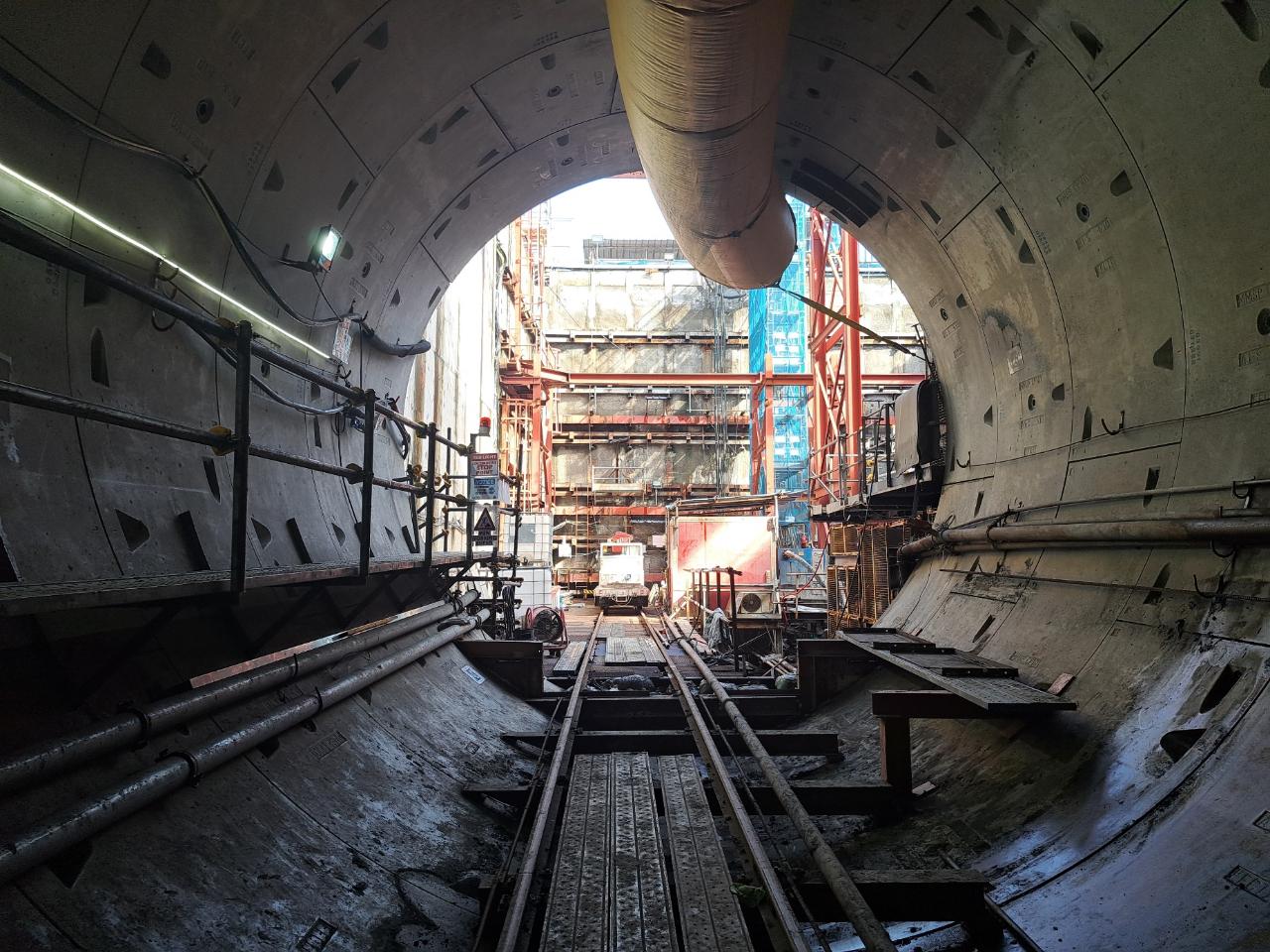
Colliers Philippines director and head of research Joey Roi Bondoc thinks the government may not take a hardline stance.
“I think it’s a massive infrastructure project and the government really has, somehow, to really give in to this request. Otherwise, it will stall and it will really retard the implementation, delay the timeline of the government,” he added.
“The best case is there should be a middle ground between what the land owners, property owners are asking for and what the government is willing to pay. I think for the government, this infrastructure project really needs to be implemented on time cause it will send a bad signal to the business community and to property investors, property developers that are banking on this massive infrastructure project committed by the government,” Bondoc said.
There are currently bills pending before Congress to amend the Right of Way Law but President Marcos has suggested maintaining the practice of the government paying 15% for the property for it to be turned over and for projects to be able to proceed.
Should there be an impasse on the land valuation, Regino in March said the government would have to expropriate properties so as not to have further project delays.
“We have now shortened the negotiation process. If there will be no agreement, we will have to file expropriation proceedings but without prejudice to continue with negotiations,” Regino said in a briefing then.
“We are doing our best to convince property owners, all things considered, that their concerns are already factored in,” he added.
Regino said the agency was now processing expropriations which would only cover underground properties. Structures on the ground level will not be touched.
He also allayed fears of the project affecting the strength of the land, as he said the subway would have the capacity to withstand strong earthquakes.
“Kung earthquake ang ano [concern] natin (If earthquakes are our concern), then the subway is even safer than staying on top of a tall building. In Japan, mas madalas nga ang lindol sa Japan pero they’re not bothered. The subway is not affected by the earthquakes,” Regino said.
“Of course, we have to consider also the overall flood control system of a city, but on top of that, the surroundings of the station. The entrance must be elevated and on top of that, we will be installing flood barriers so by and large, we’re safe from flooding,” he added.
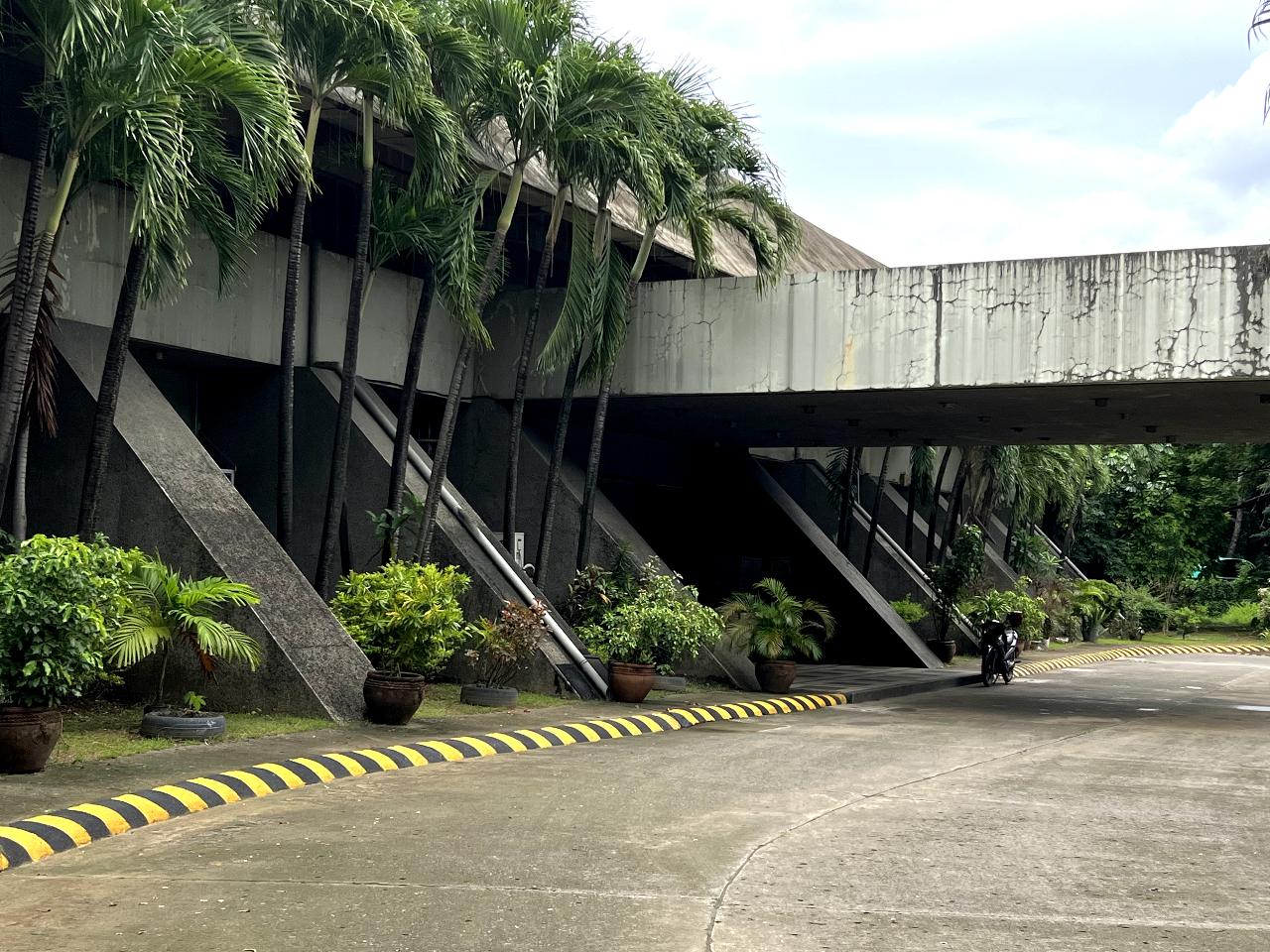
Another hurdle on the right-of-way issue that had to be hurdled over involved the Nutrition Building designed by National Artist for Architecture Leandro Locsin, which was declared a Cultural Property by the National Commission for Culture and the Arts (NCCA) as announced by Commissioner Ivan Henares in January 2024.
The original design of the MMSP had the facade of the Nutrition Building as the entrance of the Senate-DepEd station but concerns were raised about work on a heritage site and its costs. Uprooting the building and moving it to a different site was also considered.
Located on the Chino Roces Avenue Extension in Fort Bonifacio in Taguig, the Nutrition Building is the current headquarters of the National Nutrition Council (NNC).
The NNC is mandated to oversee the implementation of the hunger mitigation program and formulate national food and nutrition policies and strategies. Its 77 employees, including permanent and job-order employees, are all housed in the Nutrition Building.
The September 2017 Environmental Impact Study (EIS) for the MMSP showed that the Nutrition Building was not included in the list of cultural or historical sites affected by the project.
“Based on the field survey, the database of historical sites and structures of the National Historical Commission of the Philippines (NHCP) and the register of World Heritage Sites from the National Commission for Culture and the Arts (NCCA), there will be no historical and culturally important structures that will be directly affected by the MMSP Central Zone alignment,” the document read.
“Likewise, no Indigenous People (IPs) and ancestral domain lands will be affected by the project,” it added.
Among the historic sites located within the 2-kilometer radius of the MMSP alignment cited in the EIS are the Eugenio Lopez marker at the Benpres Building and the Julia Vargas Vda. de Ortigas market along Emerald Avenue in Ortigas, the Melchora Aquino Shrine along Tandang Sora, the Philippine Medical Association office along North Avenue, and the Philippine Expeditionary Forces to Korea Monument in Taguig.
More than two years later, however, the NNC in October 2023 filed a petition to declare the building as an Important Cultural Property. It received public positions until November 13, 2023.
“With this declaration, the DOTr had to revise its plans on the subway and make sure that the property will not be affected by any of the project’s development,” the NCCA said in an email. No responses have been received regarding requests for another interview.
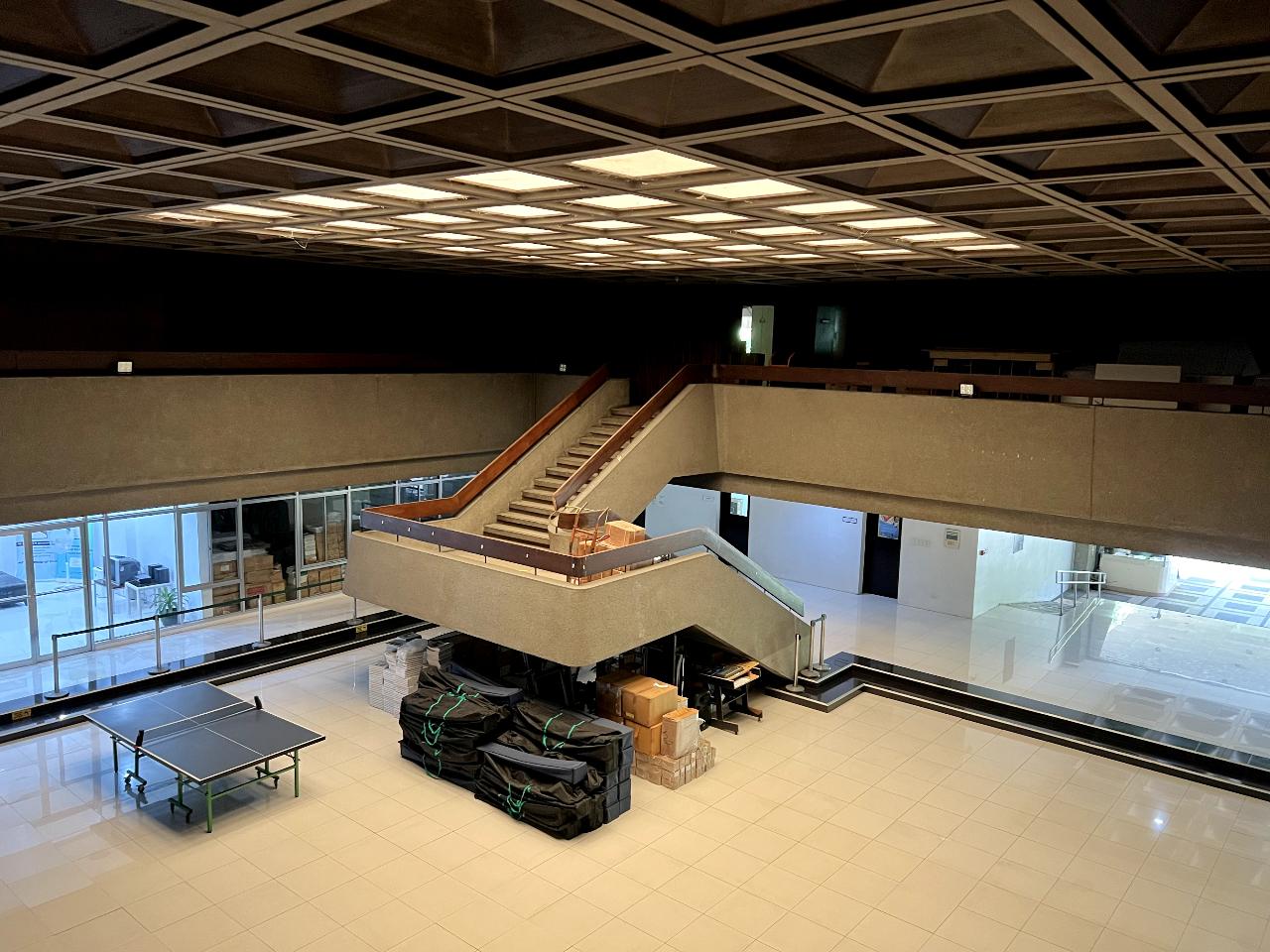
Regino confirmed the revision.
“The previous, the original design of the station would affect the Nutrition Center building, but not anymore. We moved the station to beside that building to a vacant lot. So subway tayo, dadaan pa rin tayo sa (we will still pass by the) heritage building, the Nutrition Center, pero sa ilalim na (but underground), so okay na tayo (we’re okay now).”
Nonetheless, some restoration work will be done on the Nutrition Building according to NNC Administrative Division officer-in-charge and Financial Management Division chief Cheryll Millano.
“Magkakaroon ngayon ng restoration nitong building para mapanatili ‘yung dati niyang beauty kasi, for now kasi, is medyo napabayaan kumbaga kumpara noon, so magkakaroon siya ng restoration para makita ‘yung pinaka-beauty niya talaga,” she said in a separate interview at the agency’s headquarters.
(There will now be a restoration of the building to maintain its previous beauty because for now, it has been neglected compared to before, so there will be a restoration to see its real beauty.)
Millano said the NNC has taken over the ownership of the building, but it currently sits on land owned by the Department of Education (DepEd).
“I read in the turnover report that the design has been amended to adjust to that declaration by NCCA/NHCP,” Education Secretary Juan Edgardo “Sonny” Angara, who took office in July 2024, said in a separate mobile message.
With the redesign of the station, which will cause the project’s funder Japan International Cooperation Agency (JICA) to incur additional costs, Regino said there were no more problems regarding the Nutrition Building.
“Anyway, those are all already water under the bridge kasi the Nutrition Center will stay put where it is. It will be preserved and we just moved the station so wala nang problema (there are no more problems),” he said.
U
nder the latest brief of the MMSP posted on the NEDA’s IFP site, the project is estimated to cost P488.48 billion. It was earlier approved by the NEDA with a P355.6-billion cost.
Most or P370.7 billion will be financed through an official development assistance (ODA) loan from the Japan International Cooperation Agency (JICA), while P117.7 billion will be covered by the Philippine government.
The Philippines signed the first tranche of the financing agreement for the first phase of the project with the JICA in March 2018, covering ¥104.530 billion or around P51 billion.
The second tranche, equivalent to ¥253.31 billion or P112.87 billion, was signed in February 2022, and the third tranche equivalent to ¥150 billion or about P55.37 billion was signed in March this year.
Out of its ¥507-billion commitment for the project, JICA said it has already disbursed some ¥86 billion as of mid-May 2024. JICA is also involved in the North-South Commuter Railway, whose northern line connects Clark in Pampanga and Valenzuela City.
“We decided to take up these two projects to serve as a backbone of transport in Metro Manila, by assisting through a concessional loan, so that this project could be realized earliest and traffic congestion will be somehow made lighter with the project we are going to support so that’s a very brief background on how we came into the picture,” Keisuke Fukui, JICA Senior Representative for Economic Growth, said in a separate interview.
“We also supported the feasibility study itself, because the transport roadmap which we also supported is kind of a master plan, so it’s a broad plan. After we decided to consider how we can take up the project, we provided the feasibility study support. Based on the feasibility study support, checking all the viabilities and the necessary procedures including environmental and social considerations, we provided the ODA concessional loan so that it can be basically fully financed by JICA,” he added.
Fukui cited the benefits of the project, such as more affordable fares once it becomes operational. At present the DOTr estimates the subway’s boarding fare at P22, and end-to-end fares at P26, but JICA said fares for a full trip are pegged at P88.
“The direct contribution is that towards the commuters and the people who use those transport modes, but I think the important point is that as you very well know as a Filipino, transport costs are quite high for the Filipino people,” Fukui said.
“It really gives and broadens the opportunity of the people not only in the center of Makati, but maybe around the Metro Manila region if there’s an affordable transport mode. It will give more opportunities for those people to access jobs, education, and I think that will also be a big benefit for the development of the area,” he added.
Aside from the loan, JICA also assisted in the detailed design of the MMSP. Under the agreement, contractors need to be Japanese or Japanese-led joint ventures with Filipino firms, and 30% of goods and services have to come from Japan.
The government signed a contract with Japan’s Sumitomo Corp. and Japan Transport Engineering Company for the supply of 240 train cars under contract package (CP) 107 in December 2020.
“In general, Japanese companies who have experience in the field of railways will come to this country to do the works for subway so naturally, the Japanese way of doing, the Japanese technology or Japanese know-how and experiences will also be fed into this Metro Manila Subway Project,” Fukui said.
The DOTr has awarded four contract packages for civil works of the project so far, with a number of the winning contractors listed or affiliated with firms traded on the Philippine Stock Exchange (PSE).
A joint venture led by EEI Corp. of the Yuchengco Group of Companies bagged CP 101, which covers four stations – East Valenzuela, Quirino Highway, Tandang Sora, and North Avenue, and the depot and the Philippine Railway Institute Building.
D.M. Consunji Inc., a unit of PSE-listed DMCI Holdings Inc., secured CP 102, comprising the Quezon Avenue and East Avenue stations.
Infrastructure giant Sumitomo Mitsui Construction Co. Ltd. was awarded CP 103 which involves the stations in Anonas and Katipunan, which will be located in Camp Aguinaldo.
Megawide Construction Corp., which is also involved in the Malolos Clark Railway Project, scored CP 104 which covers the Ortigas to Shaw Boulevard segment.
According to DOTr Secretary Bautista, the government has already completed the procurement process for CPs 105, 108, and 109, with awarding targeted to be done before the year ends.
CP 105 covers the underground stations in Kalayaan Avenue and Bonifacio Global City; CP 108 covers the Lawton and Senate-DepEd stations; and CP 109 covers the NAIA Terminal 3 station.
Asked if commuters can expect the subway to be on par with those already established in Japan, Fukui said it will be a mix of both Filipino and Japanese technology.
“It’s not exactly equal, because Philippines has their own way of thinking and Philippines has own standards and requirement which it has to meet, so it’s kind of a mix but we believe it will kind of be a best mix that the place where Japanese technology will be very much utilized that will be fit in,” Fukui said.
“Also, if there is something that the Philippines needs to address specifically to match the situation of the Philippines, that will also be reflected, so that kind of best mix is where we want it to happen,” he added.
Sought for comment on the current right-of-way issues, Fukui said delays in the implementation will definitely lead to substantial cost increases as contractors and consultants need to be retained but on standby, and that sudden changes to the design, such as the one seen in the Nutrition Building, could be costly.
“If you change something, many things have to be changed accordingly, like redesigning the station and that will entail quite an amount of cost. Of course it’s sometimes unavoidable, no one knows the future, but if it was well coordinated before this point in time, that could have saved some amount of money and also some amount of time,” Fukui said.
Fukui said it was best that these are addressed immediately, but that such issues are not unique to the Philippines as these are also seen in major infrastructure projects across the globe.
“I think now is the time. Now is really the time for the Philippine government to improve this, because with collaboration with other government agencies, I think there could be a way to improve and make it faster,” he said.
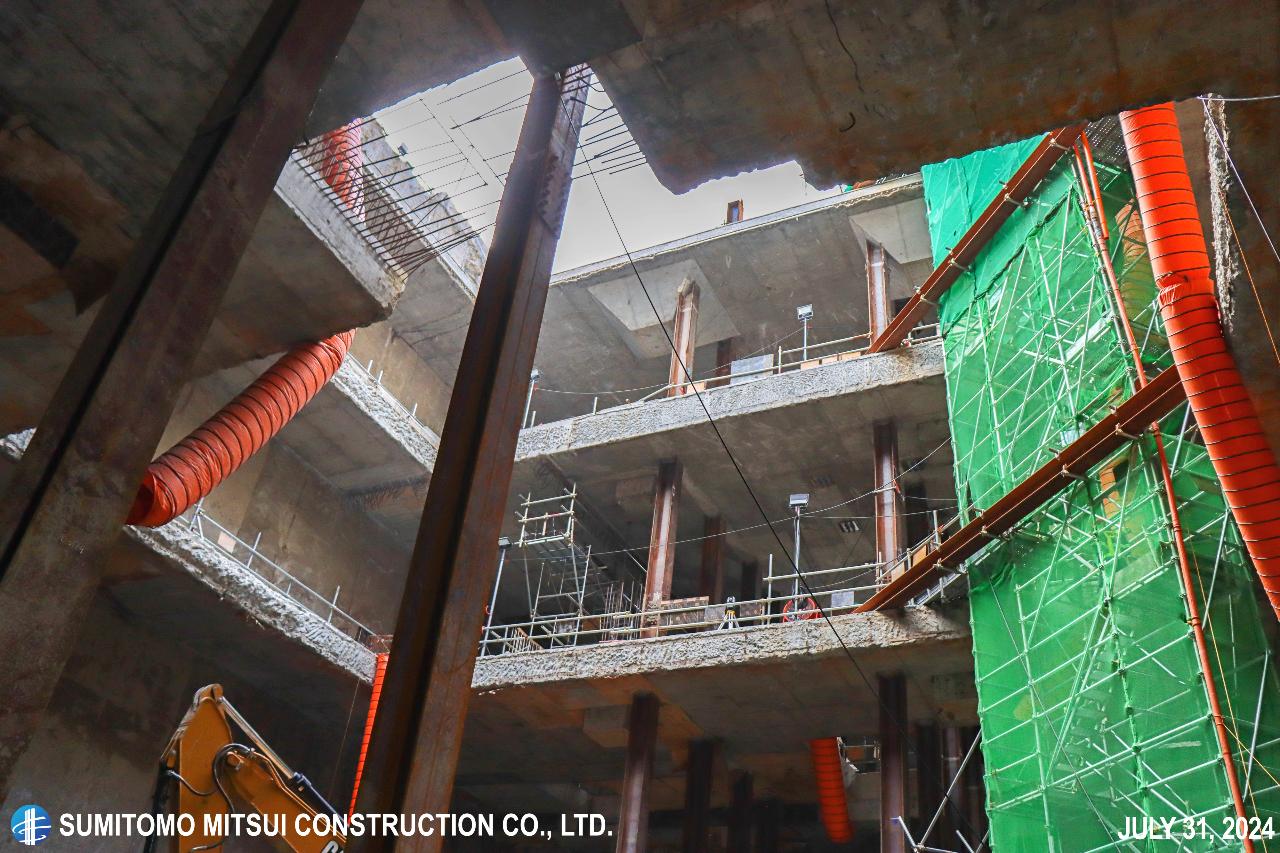
For its part, the DOTr said it commissioned JICA for a railway master plan which is set to be finalized by 2025. This will involve studies on the need for new rail lines and the interconnection of railway systems that cover Greater Metro Manila and even areas outside the region.
With more railways on the works, Regino said it would be more beneficial to have underground rails as it would be easier to secure right of way for such projects, compared with elevated railways where properties will have to be moved and relocation would have to be done.
“In the future in Metro Manila, magiging impractical na. In the future, it’s going to be impractical to build new lines in Metro Manila that would be elevated,” Regino said.
Moving forward, commuters like Emerrie will have to wait for more alternative modes of transportation to be put up in Metro Manila.
“There is a big clamor for mas efficient public transpo, and sana mag-work tayo towards doon kasi sa nakikita natin, ‘yung every day lang na report sa Commonwealth na bumper-to-bumper, sobrang nakakapagod tignan lang, lalo na ‘pag na-experience mo siya,” she said.
(There is a big clamor for more efficient public transport, and hopefully, we work towards that because from what we see, the every day report on Commonwealth with bumper-to-bumper, it is really tiring just to look at, what more to experience.)
“Sana going to 2029 doon na tayo papunta sa efficient mass public transpo, and i-regulate din ‘yung private vehicles,” she added.
(Hopefully, going to 2029, we are heading toward an efficient mass public transport, and also regulate the private vehicles.) —NB, GMA Integrated News
This story was produced through a grant from Internews’ Earth Journalism network through the Asian Center for Journalism at the Ateneo de Manila.





